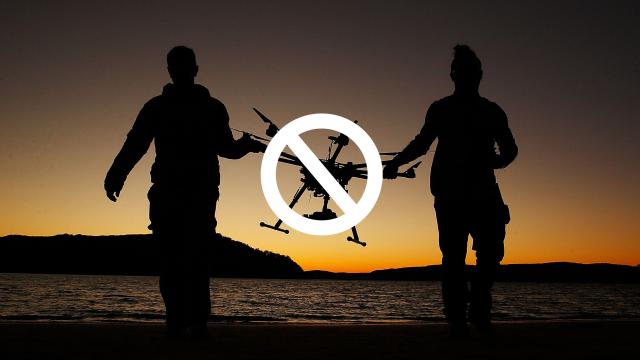There are plenty of very good, fun, and helpful things that drones can do — things like monitoring crops and delivering beer and saving lives. Unfortunately, over the weekend, the Federal Aviation Administration (FAA) released the first draft of its rules for commercial drones, and guess what? The rules would make a lot of those things illegal.
The proposed rules bear some pretty serious implications for the future of drone-driven businesses. Although the agency is not being so strict as to require a pilot’s licence, as previously reported, it does propose that drone operators must:
- remain within an unaided visual line-of-sight of the drone
- not operate over people not involved with the mission
- not operate at night
- maintain an altitude of less than 500 feet
These among other restrictions.
The biggest wet blanket is that “visual line-of-sight” restriction, which means the drone can’t travel further than its operator can see it with their naked eyes. Doesn’t matter if the drone is equipped with cameras and a live video feed — if you can’t see the drone from the ground, you can’t fly it commercially. That rules out a handful of the more futuristic applications for drones that entrepreneurs and corporate giants alike have dreamed up, most obviously delivering anything from pizza can help farmers monitor if their irrigation systems are working, how their plants are growing, even see if any of the plants are sick by using thermal and hyperspectral cameras. However, some farms are pretty big — bigger than the eye can see.
Drones are already being used to inspect oil rigs in Alaska, transport medicine, and help emergency responders save lives. If the visual line-of-sight rule becomes law, those could run up against the same limitations, unless those drone operators get special permission from the federal agency.
You could also wave goodbye to a lot of incredible photos and video that mechanical fliers can capture from their eyes-in-the-sky. Drones are great for filming sports and, well, pretty much any big event that looks even more interesting when viewed from above or from a considerable distance. But the visual line of site restriction would be a major limit on how far and how high drones can go for the striking footage. Would we have ever seen this close-up volcano eruption if Iceland had a line-of-sight rule on the books?
On a more Orwellian note, the FBI is busy using drones for surveillance, and the proposed rule would likely limit their reach as well — though we can probably expect law enforcement to be given some exceptions.
What the visual line of sight restriction doesn’t hamper, the 500-foot altitude limit could quash. Environmental drones can be used for everything from testing air quality to inspecting the makeup of the ozone — a trend that’s only supposed to get more popular. But the proposed altitude restrictions would require a special permit for the aircraft to fly higher than 500 feet, which environmental drones would certainly want to do.
In some ways, rule number 2 seems obvious: drones shouldn’t be allowed to operate over people not involved with the mission. No flying over strangers means no noisy invasions of privacy, no paparazzi peeking into events they’re not supposed to see, no heavy metal drones accidentally landing on someone’s head. But it also seems like an awfully difficult thing to control at any sort of public spectacle that one might want to film from the air. Or journalists, for that matter. Helicopters fly above people all the time. Would you rather have a two-ton news chopper or a 55-pound drone above you in the sky?
And what about swarming drones? In the past, we’ve seen drones work together to build and weave tensile structures. However, the proposed rules state that “No person may act as an operator or VO for more than one unmanned aircraft operation at one time.” This could potentially rule out swarms of drones constructing things together.
Of course, it’s too soon to know for sure. These proposed rules are just that: proposed. And some exceptions will be made, namely to drones that weigh less than 4.4 pounds. These rules also do not apply to model aircraft, the term that the FAA uses to refer to recreational drones and RC planes and the like. Still, the rules could set a precedent that might be applied to new model aircraft rules too, if and when the FAA decides to write them.
Meanwhile, the public gets 60 days to comment on the rules after they have been published in the Federal Register. There’s still time to speak your mind before everything is finalised — or at least before you kiss your pizza drone delivery dream goodbye.
